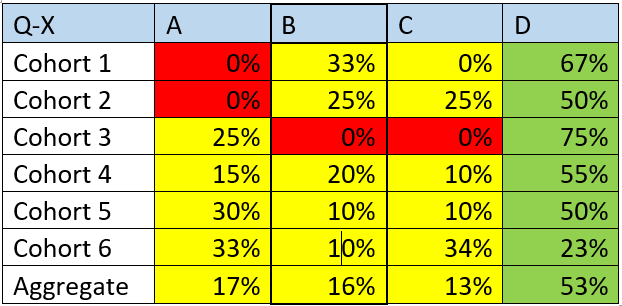As the world of human capital management continues to evolve and change so do the tools and  techniques that measure and drive performance. One of the tools that has captured the attention of many organizations is data analytics. Data analytics has moved from an isolated concept such as “Moneyball” to mainstream practical applications that transcends everything from politics to the way organizations create culture. The purpose of this blog is to share interesting insights into how data analytics from Business Simulations are helping to change organizational culture.
techniques that measure and drive performance. One of the tools that has captured the attention of many organizations is data analytics. Data analytics has moved from an isolated concept such as “Moneyball” to mainstream practical applications that transcends everything from politics to the way organizations create culture. The purpose of this blog is to share interesting insights into how data analytics from Business Simulations are helping to change organizational culture.
The Four Types of Data Analytics
With so much data available and so many people trying to figure out what to do with it, it’s important to stay focused on the four primary uses of data analytics:
Prescriptive
This type of analytics shows what actions should be taken.
Predictive
This type of analytics provides the ability to forecast what will happen.
Diagnostic
This type of analytics looks at past performance to determine why things happened.
Descriptive
This type of analytics provides insights into what is happening now.
These four types of approaches can be used to analyze data coming from business simulations.
Analytics from Business Simulations
Over the past year, I have had the privilege of supporting several large companies by designing, developing, and delivering a Fundamentals of Leadership simulation. The purpose of the simulation is to provide the skills and tools needed to develop a strong and realistic leadership culture of accountability and success.
In the simulation, small teams (3-4 participants) collectively take on the role of a new leader weaving through more than 30 different leadership scenarios working with simulated peers, direct reports, customers, and other key stakeholders. Every scenario presents participants with different options and the chance to learn about the best practices of leadership. And just like the real world, nothing is every as it seems and nothing is ever black and white; there are always layers of ambiguity.
As we rolled out the simulation in cohorts, we keep track of the data from every scenario and regularly perform analytics which is shared with the client. The data for 30 scenarios is fascinating and truly provides the opportunity to be prescriptive, predictive, diagnostic, and descriptive.
For sharing purposes, let’s examine the data analytics for just one scenario about coaching your team to have difficult conversations, diffusing conflict, and giving feedback.
The character of “Ellen” is a strong performer, but she also has an overly aggressive, confrontational  style. She recently got into a shouting match with another team member, Theo, about who had the right to use a conference room. And a customer was on the phone during the entire incident! Ellen later apologized but was still not being very collegial to Theo and continued to bad mouth Theo behind his back. You as the manager got together with Ellen to provide feedback and coaching, Ellen shared some things about Theo and their relationship that you didn’t know including the fact that Ellen has been covering up some of Theo’s mistakes to try to mentor him. You also discovered that Ellen did indeed have the conference room scheduled and Theo didn’t respect Ellen enough to ask if it was ok to have for a few minutes to take the very important customer call. Regardless of that new information, you as the manager must take action with Ellen, what do you do?
style. She recently got into a shouting match with another team member, Theo, about who had the right to use a conference room. And a customer was on the phone during the entire incident! Ellen later apologized but was still not being very collegial to Theo and continued to bad mouth Theo behind his back. You as the manager got together with Ellen to provide feedback and coaching, Ellen shared some things about Theo and their relationship that you didn’t know including the fact that Ellen has been covering up some of Theo’s mistakes to try to mentor him. You also discovered that Ellen did indeed have the conference room scheduled and Theo didn’t respect Ellen enough to ask if it was ok to have for a few minutes to take the very important customer call. Regardless of that new information, you as the manager must take action with Ellen, what do you do?
B) Share with Ellen that she needs to have hard yet constructive conversations with Theo and work through tough issues
C) When Theo feels threatened, he shuts down and then solicits others to commiserate with him and plot against Ellen causing productivity and potential legal issues
D) Share with Ellen that she needs to be a lot nicer to Theo
The choice that our client selected as the best practice answer is B. The primary reason is that senior leadership thinks that organization is conflict averse and does not have the skills or tools to have difficult conversations. So take a look at the data coming from the first 6 cohorts:

The aggregate average for A is 17%, B is 16%, C is 13%, and D is 53%. The diagnostic analysis of this scenario illustrates that the organization feels more comfortable avoiding conflict.
Based on the data and based on the results, our facilitation team shared with the cohorts that they need to focus on the skills and tools needed to have hard conversations. In addition, we are providing every participant with reinforcement scenarios to practice having these hard conversations and providing real-time coaching over their smartphones.
And that’s just for one scenario! By using data analytic techniques on all of the scenarios we are able to find patterns and relate them back to both their competency model and their core values for further improvement.




